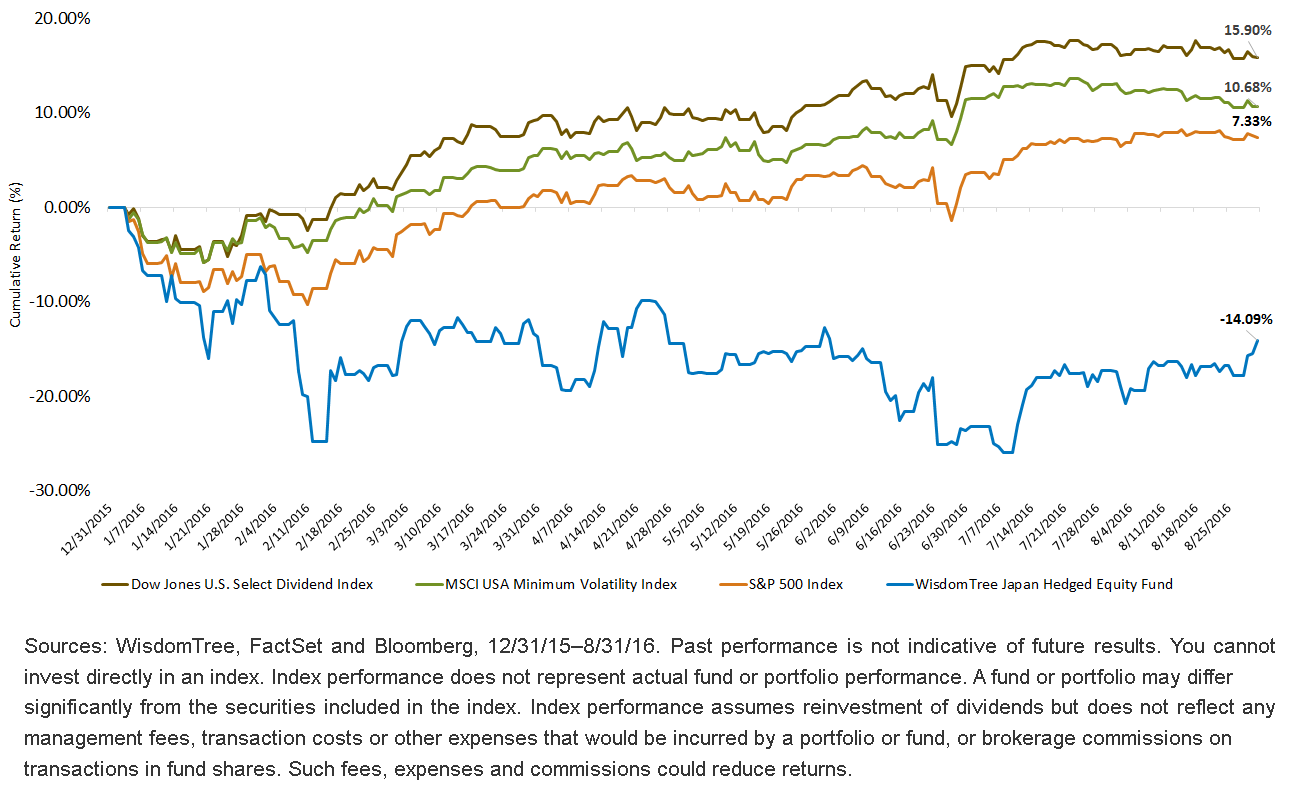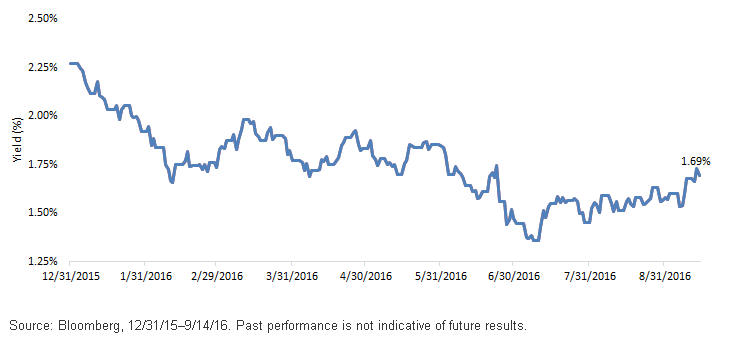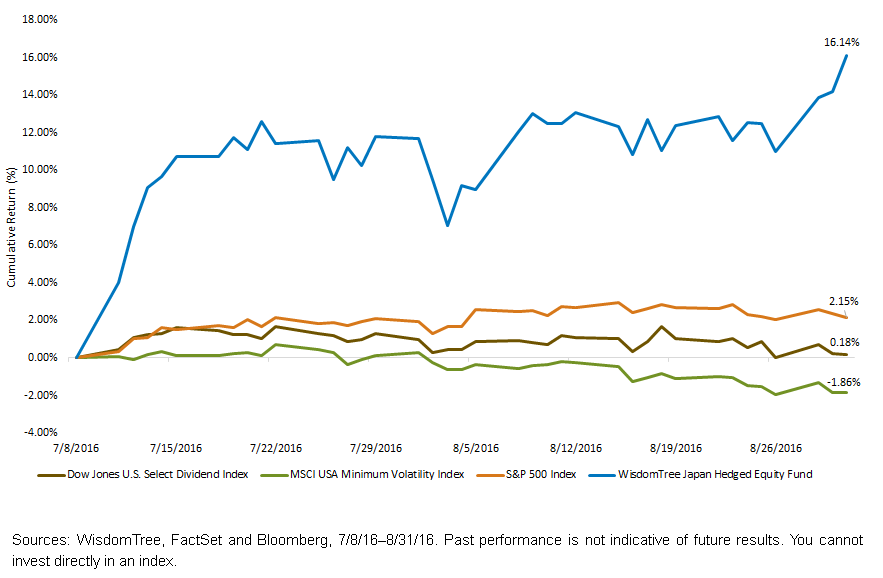The Other Side of the Low Volatility Trade


 For definitions of indexes in the chart, visit our glossary.
In my opinion, the outperformance of low-volatility and high-dividend strategies and underperformance of Japan are two sides of the same coin and are driven by the same fundamental force: a declining U.S. interest rate environment that saw the U.S. 10-year yield decline from more than 2.2% at the start of the year to a low of 1.36% on July 8.
The Turning Point: July 8
However, since July 8, two things have happened:
1) Interest rates bottomed and started to rise from their lows following stronger jobs reports in the U.S.
2) Japanese Prime Minister Abe recorded a major political victory that saw his party and coalition win the upper house elections, and he received a bigger mandate for governing Japan. He has since passed a fiscal stimulus plan to support the economy.
U.S. 10-Year Government Bond Yields
For definitions of indexes in the chart, visit our glossary.
In my opinion, the outperformance of low-volatility and high-dividend strategies and underperformance of Japan are two sides of the same coin and are driven by the same fundamental force: a declining U.S. interest rate environment that saw the U.S. 10-year yield decline from more than 2.2% at the start of the year to a low of 1.36% on July 8.
The Turning Point: July 8
However, since July 8, two things have happened:
1) Interest rates bottomed and started to rise from their lows following stronger jobs reports in the U.S.
2) Japanese Prime Minister Abe recorded a major political victory that saw his party and coalition win the upper house elections, and he received a bigger mandate for governing Japan. He has since passed a fiscal stimulus plan to support the economy.
U.S. 10-Year Government Bond Yields
 Since that bottom of interest rates and the upper house victory on July 8, low-volatility and high-dividend stocks have reversed their year-to-date strong performance and started to underperform the S&P 500, and Japan has outperformed significantly, by more than 10 percentage points from July 8 to August 31.
Reversal of Low-Volatility and High-Dividend Stocks Paired with Strong Outperformance of Japan
Since that bottom of interest rates and the upper house victory on July 8, low-volatility and high-dividend stocks have reversed their year-to-date strong performance and started to underperform the S&P 500, and Japan has outperformed significantly, by more than 10 percentage points from July 8 to August 31.
Reversal of Low-Volatility and High-Dividend Stocks Paired with Strong Outperformance of Japan
 How Much Interest Rate Risk Do You Have in Your Equity Portfolio?
Investors who have been embracing the low-volatility/high-dividend/utilities sector trade should be aware of how much “bond duration” or interest rate risk they may have added to their portfolios. If interest rates continue to rise, these three areas of the market could face a tough period of performance and compound poor returns from bond-like allocations, in our view.
One of the best hedges for rising interest rates in the U.S. is Japanese equity exposure. Japanese companies are very exposed to the U.S. economy—it is one of their biggest profit centers. A strengthening U.S. economy that supports rising U.S. interest rates is one of most supportive fundamental drivers of Japan. A strengthening U.S. economy also hurts these lower-volatility and utilities-oriented equity exposures in U.S. markets, which are fairly interest-rate-sensitive and more expensive than normal today.
For those investors like me who think the low-volatility trade of 2016 ended on July 8, I would add positions to Japanese equities, particularly on a currency-hedged basis, as that also may have marked the bottoming of Japanese equities’ underperformance. Again, I view these as two sides of the same interest rate coin. If rates bottomed, so too did Japan.
Unless otherwise noted, data source is Bloomberg, as of 8/31/16.
How Much Interest Rate Risk Do You Have in Your Equity Portfolio?
Investors who have been embracing the low-volatility/high-dividend/utilities sector trade should be aware of how much “bond duration” or interest rate risk they may have added to their portfolios. If interest rates continue to rise, these three areas of the market could face a tough period of performance and compound poor returns from bond-like allocations, in our view.
One of the best hedges for rising interest rates in the U.S. is Japanese equity exposure. Japanese companies are very exposed to the U.S. economy—it is one of their biggest profit centers. A strengthening U.S. economy that supports rising U.S. interest rates is one of most supportive fundamental drivers of Japan. A strengthening U.S. economy also hurts these lower-volatility and utilities-oriented equity exposures in U.S. markets, which are fairly interest-rate-sensitive and more expensive than normal today.
For those investors like me who think the low-volatility trade of 2016 ended on July 8, I would add positions to Japanese equities, particularly on a currency-hedged basis, as that also may have marked the bottoming of Japanese equities’ underperformance. Again, I view these as two sides of the same interest rate coin. If rates bottomed, so too did Japan.
Unless otherwise noted, data source is Bloomberg, as of 8/31/16.
Important Risks Related to this Article
There are risks associated with investing, including possible loss of principal. Foreign investing involves special risks, such as risk of loss from currency fluctuation or political or economic uncertainty. The Fund focuses its investments in Japan, thereby increasing the impact of events and developments in Japan that can adversely affect performance. Investments in currency involve additional special risks, such as credit risk and interest rate fluctuations. Derivative investments can be volatile, and these investments may be less liquid than other securities, and more sensitive to the effects of varied economic conditions. As this Fund can have a high concentration in some issuers, the Fund can be adversely impacted by changes affecting those issuers. Due to the investment strategy of this Fund, it may make higher capital gain distributions than other ETFs. Please read the Fund’s prospectus for specific details regarding the Fund’s risk profile.

Jeremy Schwartz has served as our Global Chief Investment Officer since November 2021 and leads WisdomTree’s investment strategy team in the construction of WisdomTree’s equity Indexes, quantitative active strategies and multi-asset Model Portfolios. Jeremy joined WisdomTree in May 2005 as a Senior Analyst, adding Deputy Director of Research to his responsibilities in February 2007. He served as Director of Research from October 2008 to October 2018 and as Global Head of Research from November 2018 to November 2021. Before joining WisdomTree, he was a head research assistant for Professor Jeremy Siegel and, in 2022, became his co-author on the sixth edition of the book Stocks for the Long Run. Jeremy is also co-author of the Financial Analysts Journal paper “What Happened to the Original Stocks in the S&P 500?” He received his B.S. in economics from The Wharton School of the University of Pennsylvania and hosts the Wharton Business Radio program Behind the Markets on SiriusXM 132. Jeremy is a member of the CFA Society of Philadelphia.

